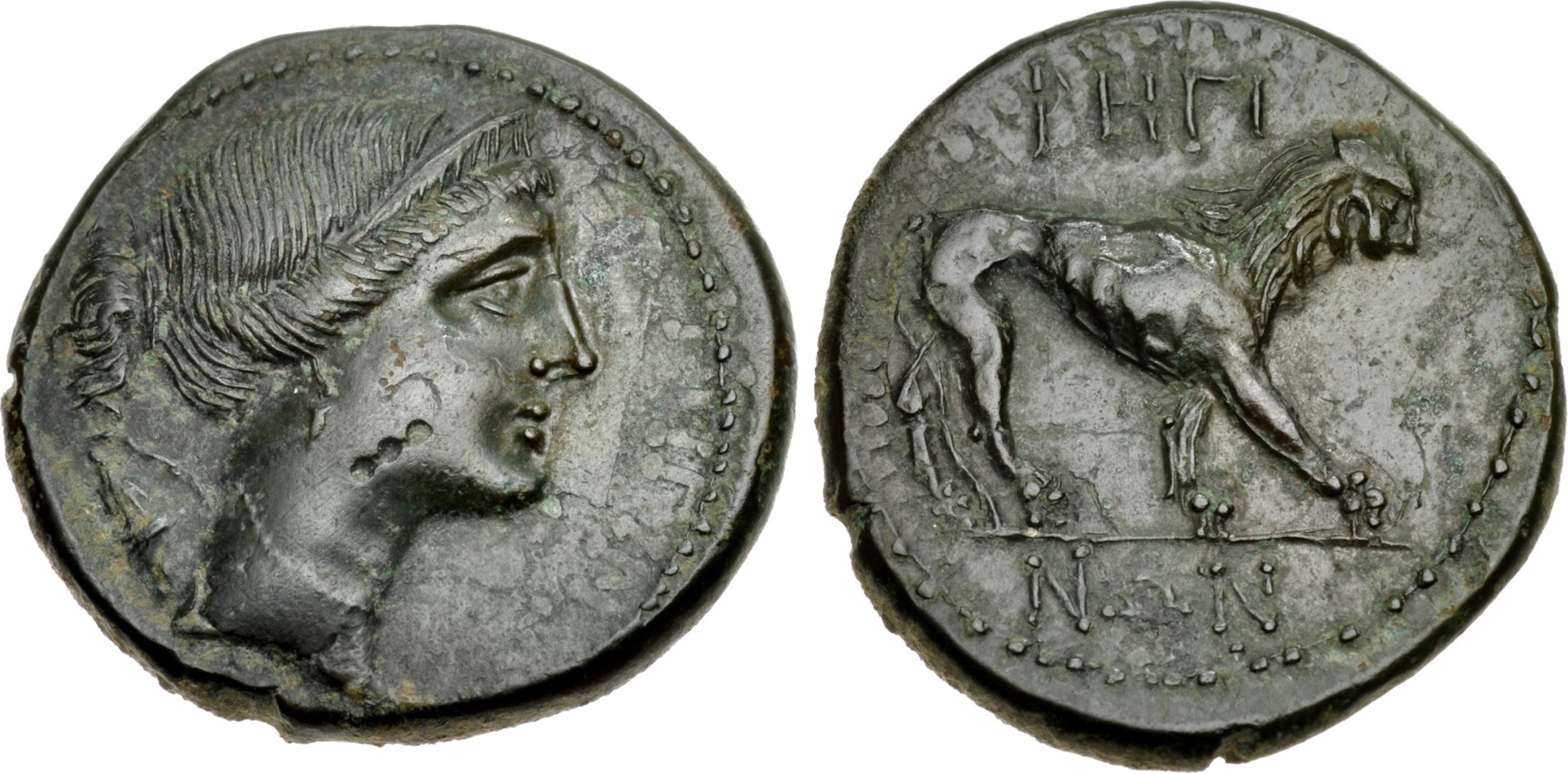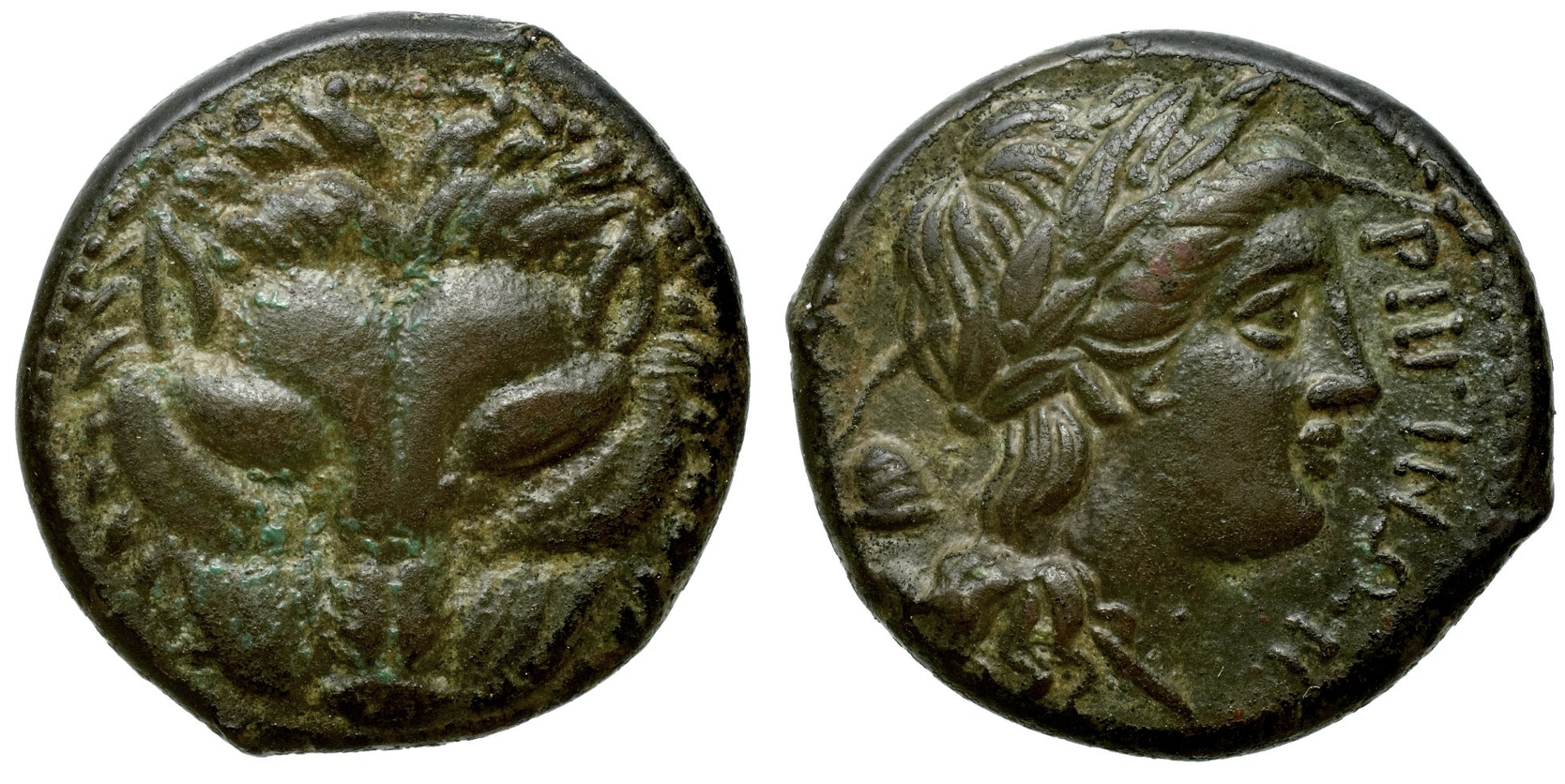260 BCE - 215 BCE | ΡΗΓΙΝΩΝ
Overstriking coin
SO 1413 - Rhegium over Rhegium.jpg
[1]
Overstruck variety
BnF Armand Valton 111.png
[2]
|
|
Sale(s)Sale(s) ᵖ:
|
Classical Numismatic Group 94 (18/09/2013), lot 68 ; Classical Numismatic Group Stock 719050 (02/2000)
|
| Private collection(s)Private collection(s) ᵖ:
|
J. M. G. Collection
|
|
Description
| ObverseInscription or printing placed on the obverse.:
|
Head of Artemis right, wearing diadem, bow and quiver over shoulder. Border of dots.
|
ReverseInscription or printing placed on the reverse.:
|
ΡΗΓΙΝΩΝ (Greek) Lion walking right. Border of dots.
|
Mint and issuing power
| MintIdentifies the place of manufacture or issue of a numismatic object.:
|
Rhegium
|
Ancient regionAncient region.
|
Bruttium
|
Modern countryModern country: Italy
|
AuthorityIdentifies the issuing power. The authority can be "pretended" when the name or the portrait of X is on the coin but he/she was not the issuing power. It can also be "uncertain" when there is no mention of X on the coin but he/she was the issuing power according to the historical sources:
|
|
Chronology
| FromIdentifies the initial date in a range assigned in a numismatic context. 260 BCE toIdentifies the final date in a range assigned in a numismatic context.. 215 BCE
|
Hellenistic 323-30 BC  periodTime period of the numismatic object. periodTime period of the numismatic object.
|
Physical description
MetalThe physical material (usually metal) from which an object is made.: Bronze 
|
WeightWeight of the numismatic object (in grams). in grams: 7.927.92 g <br />7,920 mg <br />
|
|
AxisDescribes the directional relationship between the obverse and reverse of a numismatic object.: 99 mm <br />0.9 cm <br />
|
| DiameterDescribes diameter of an object (in mm).: 2222 mm <br />2.2 cm <br />
|
|
References
Description
| ObverseInscription or printing placed on the obverse.:
|
Head of Apollo (visible on the obverse: profile and legend)
|
ReverseInscription or printing placed on the reverse.:
|
|
Mint and issuing power
| MintIdentifies the place of manufacture or issue of a numismatic object. ᵖ:
|
Rhegium
|
Ancient regionAncient region. ᵖ
|
Bruttium
|
Modern countryModern country: Italy
|
AuthorityIdentifies the authority in whose name (explicitly or implicitly) a numismatic object was issued. ᵖ:
|
|
Chronology
| FromIdentifies the initial date in a range assigned in a numismatic context. 351 BCE toIdentifies the final date in a range assigned in a numismatic context.. 280 BCE
|
Classical 480-323 BC  periodTime period of the numismatic object. periodTime period of the numismatic object.
|
Physical description
References
| Frequency of overstrikesFrequency of overstrikes:
|
frequent
|
Level of confidenceLevel of confidence of the identification:
|
strong
|
| RemarksRemarks:
|
"overstruck on earlier issue of Rhegion, probably HN Italy 2537 (head of Apollo and ethnic are visible in the field on the obverse)"
|
References
- ^ Troxell, Hyla A. (1975), Sylloge Nummorum Graecorum ANS 3. The Collection of the American Numismatic Society. Sicily 3 (Bruttium-Sicily I: Abacaenum-Eryx), New-York, pl. 38.
- ^ Price, Martin J. (1995), Sylloge nummorum graecorum. Great Britain. Vol. X : The John Morcom collection of Western Greek bronze coins, London - Oxford, Oxford University Press ; Spink and Son, 95 p., 38 pl.
- a b Rutter N. Keith et alii (eds.) (2001), Historia Numorum Italy, London, xvi, 223 p., 43 pl.
- ^ Hoover, Oliver D. (2018), The Handbook of Greek Coinage Series, Volume 1. Handbook of Coins of Italy and Magna Graecia, Sixth to First Centuries BC., Lancaster-London, 2018, lxi, 527 pages, 23 cm

